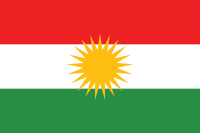Kurdistan (state)
imaginary state that the Kurdish nationalists want to be established in the Kurdish-dominated regions
Kurdistan (Kurdish: کوردستان or Kurdistan), is a imaginary state that the Kurdish nationalists want to be established in the Kurdish-dominated regions. Kurdish population is estimated to be between 36.4 and 45.6 million.
Republic of Kurdistan Komâre Kurdistan (Kurmanji) کۆماری کوردستان (Sorani) | |
|---|---|
| Motto: ئازادی یان ئازادی, "An azadî, an azadî" (Kurdish) (English: "Either freedom, or freedom") | |
| Anthem: ئەی ڕەقیب, "Ey Reqîb" (Kurdish) (English: "O Enemy") | |
 Map of Kurdistan claimed by Kurdish nationalists | |
| Capital | Erbil (de facto)a Kirkuk[1] (de jure)a |
| Official languages | Kurdisha[2] |
| Recognized languagesa[3] |
|
| Religion | Secular statea |
| Government | |
• President | Nechirvan Barzania |
• Prime Minister | Masrour Barzania |
• Deputy Prime Minister | Qubad Talabania |
a in Kurdistan Region of Iraq | |
List of presidents
Official status
 Kurdistan Region (1992) – It is an autonomous region[6] in Iraq.
Kurdistan Region (1992) – It is an autonomous region[6] in Iraq.
 Autonomous Administration of North and East Syria[b] (2013) – It is an autonomous region in Syria.
Autonomous Administration of North and East Syria[b] (2013) – It is an autonomous region in Syria.
Flag
The flag of Kurdistan (Kurdish: ئاڵای کوردستان, Alaya Kurdistanê) is the flag of Kurds[12][13][14] and created by the Society for the Rise of Kurdistan in 1920. It would later, in different variants, be adopted as the national flag of different Kurdish states including Republic of Ararat, Republic of Mahabad and most recently by Kurdistan Region in 1992. Moreover, the Kingdom of Kurdistan used the crescent flag which was also considered a Kurdish flag.[14]

References
Sources
- Lister, Charles R. (2015). The Syrian Jihad: Al-Qaeda, the Islamic State and the Evolution of an Insurgency. Oxford University Press. ISBN 978-0-19-046247-5.
- Allsopp, Harriet; van Wilgenburg, Wladimir (2019). The Kurds of Northern Syria. Volume 2: Governance, Diversity and Conflicts. London; New York City; etc.: I.B. Tauris.
- Watts, Nicole F. (2010a). Activists in Office: Kurdish Politics and Protest in Turkey (Studies in Modernity and National Identity). Seattle: University of Washington Press. p. 167. ISBN 978-0-295-99050-7.
The overwhelming majority of voters supporting pro-Kurdish candidates came from thirteen provinces: Ağri, Bingöl, Bitlis, Diyarbakır, Hakkari, Mardin, Muş, Siirt, Tunceli, Van, Batman, Șırnak, and Igdır. In all these provinces the population is at least 50 percent Kurdish (...)
- Watts, Nicole F. (2010b). Activists in Office: Kurdish Politics and Protest in Turkey (Studies in Modernity and National Identity). Seattle: University of Washington Press. p. 167. ISBN 978-0-295-99050-7.
In addition, provinces with sizeable Kurdish minorities such as Urfa (where about 47 percent of the population is estimated to be Kurdish) and Kars (about 20 percent Kurdish) (...)
- Courbage, Youssef; Todd, Emmanuel (2011). A Convergence of Civilizations: The Transformation of Muslim Societies Around the World. Columbia University Press. pp. 74.
Kurds are also a majority of the population in the provinces of Kermanshah, West Azerbaijan, and Ilam.
Notes
🔥 Top keywords: Main PageSpecial:SearchModule:Track gauge/dataSOLID (object-oriented design)Wikipedia:AboutHelp:ContentsHelp:IntroductionSpecial:RecentChangesPornhubBlackAdolf Hitler UunonaFile:ASCII-Table-wide.svgList of constituencies of the Lok SabhaList of U.S. states and territories by time zoneSchrödinger's catList of U.S. states by date of admission to the UnionFile:Sexual intercourse with internal ejaculation.webmHeera MandiList of people who have walked on the MoonDavid24-hour clockModule:Emoji/dataLawrence WongCristiano RonaldoPeriodic tableList of countries by areaUnited StatesCategory:2000s American music groupsList of U.S. statesBismillahir Rahmanir RaheemList of fruitsQueen (band)Special:MyTalkXXXTentacionWikipedia:Contact usHelp:Authority controlWikipedia:Simple talkList of countries by continentsWikipedia:Simple start











